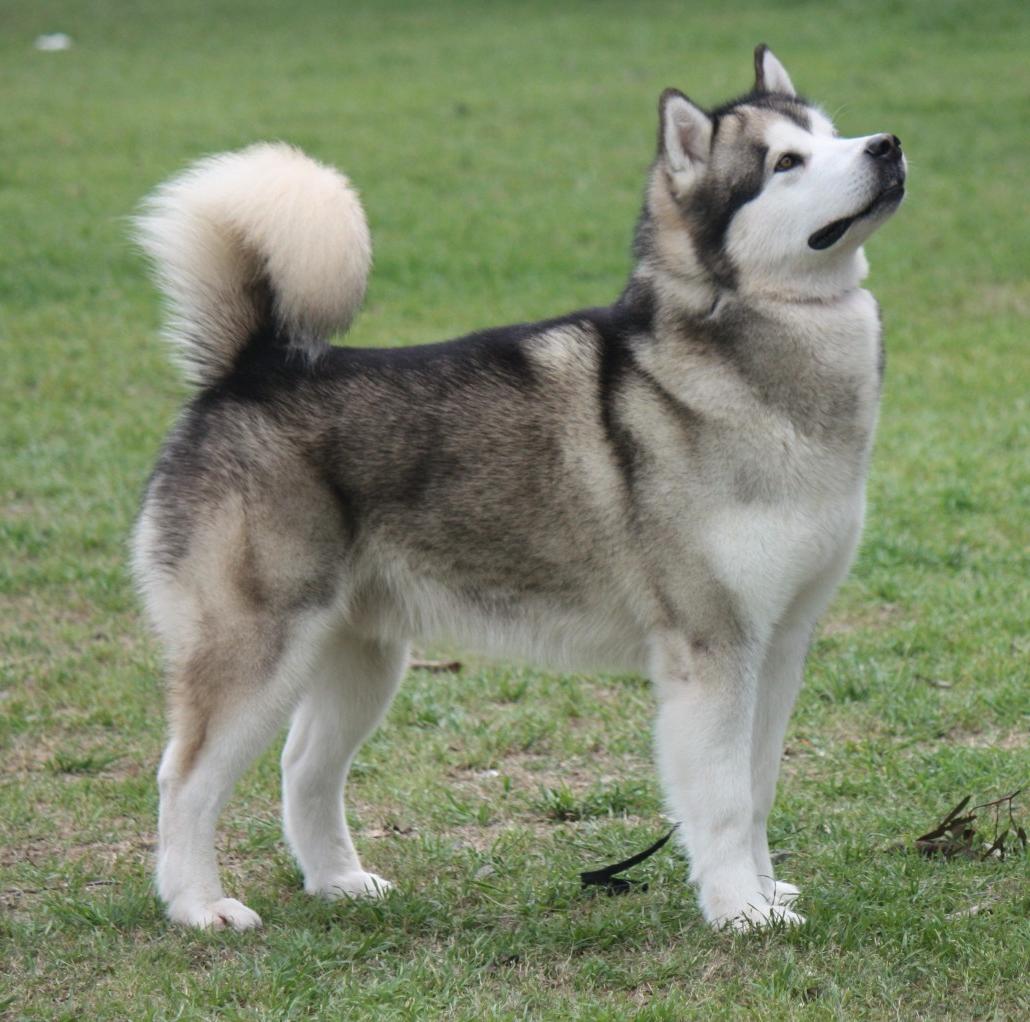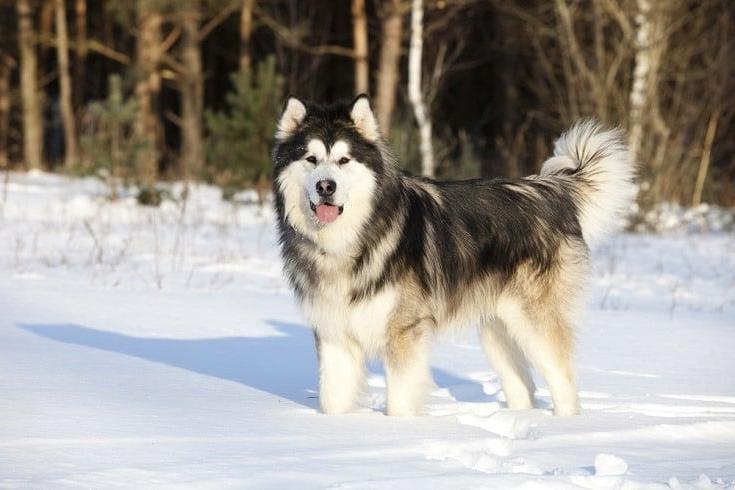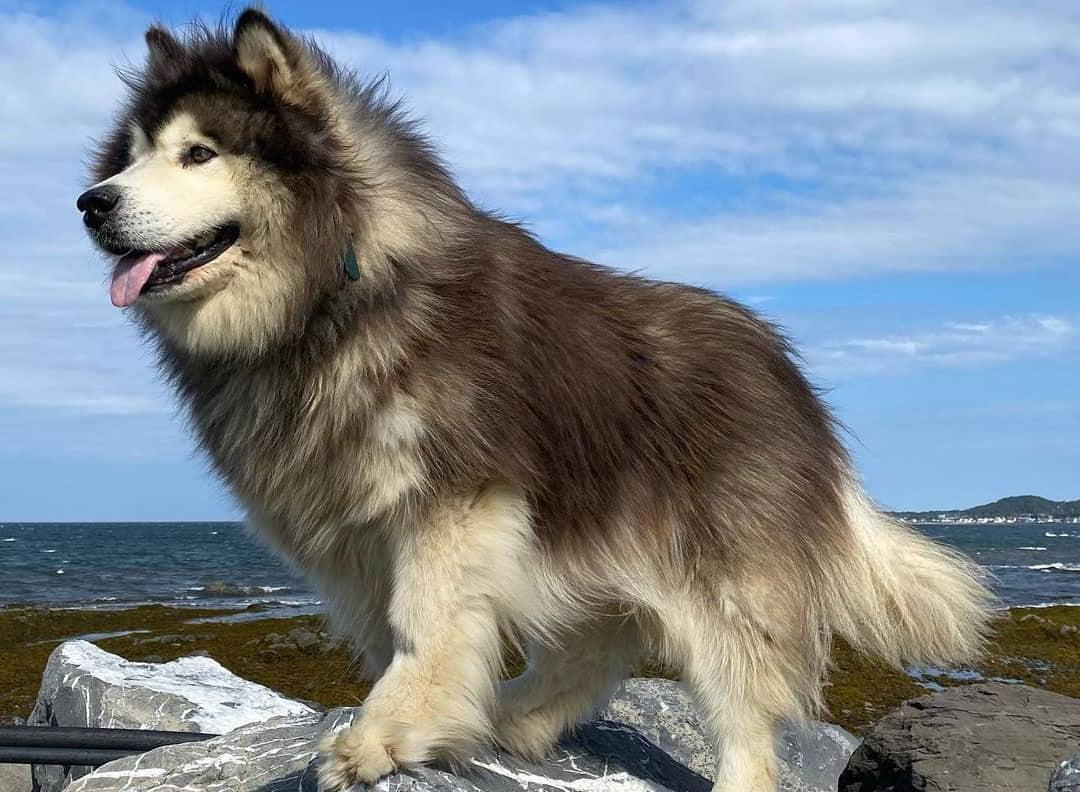- Breed Category: Working Group
- Country of Origin: United States
- Average Height: Males 63.5 cm, Females 58.5 cm
- Average Weight: Males 38 kg, Females 34 kg
- Average Life Span: 10 to 14 years
- Grooming Requirements: Weekly brushing, more during shedding
- Exercise Requirements: High, needs daily exercise
- Coat Type: Thick double coat
- Coat Color Variations: Grey, black, sable, red, white
- Shedding Level: Heavy, especially seasonally
- Ear Type: Erect and triangular
- Tail Type: Plumed, carried over back
- Temperament: Friendly, loyal, playful
- Intelligence Level: High, independent thinker
- Barking Tendency: Low, more likely to howl
- Compatibility with Children: Good, but supervision needed
- Compatibility with Other Pets: Can be good with training
- Training Ease: Moderate, requires patience
- Common Health Issues: Hip dysplasia, cataracts
- Dietary Needs: High-quality, balanced diet
- Energy Level: High, needs active lifestyle
- Drooling Tendency: Low
- Sensitivity to Weather: Tolerates cold well, heat sensitive
- Overall Maintenance Level: Moderate to high
- Original Purpose: Sled pulling, hunting
- Year of Recognition by Kennel Clubs: 1935
- Apartment Friendly: Not ideal, needs space
- Best Suited For: Active families, large yards
- Cost of Ownership: Moderate to high
- Unique Traits: Strong, endurance, pack-oriented
- Cultural Significance: Integral to Inuit culture
- Popularity Rank: Popular in working dog category
Imagine a dog as strong as a sled and as loyal as your best mate. That’s the Alaskan Malamute for you. This breed isn’t just a pretty face; it’s a powerhouse with a rich history. Originating from the Arctic, these dogs were bred by the Mahlemut Inuit people to haul heavy loads across icy terrains. Their strength and endurance are legendary, making them indispensable in harsh climates. This article will dive into the Malamute’s unique characteristics, fascinating history, and essential care tips. Whether you’re considering adding one to your family or just curious, you’ll find everything you need to know about this remarkable breed. Let’s explore what makes the Alaskan Malamute truly special.
Alaskan Malamute: A Breed with a Rich Heritage

Early Development of the Breed
The Alaskan Malamute traces its roots back to the Arctic, where the Mahlemut Inuit people first bred these dogs. They needed a breed that could withstand the harsh, icy conditions and help with heavy sledding tasks. Over time, the Malamute’s strength and resilience became its defining traits, making it a vital part of the Inuit community.
Role in Alaskan Sledding and Exploration
These dogs weren’t just about pulling sleds; they were essential for survival. During the Alaskan Gold Rush, their ability to transport goods and people across treacherous terrains was invaluable. Explorers and adventurers relied on Malamutes for their unmatched endurance and loyalty.
Key Historical Figures
Figures like Roald Amundsen, the famed polar explorer, recognised the Malamute’s capabilities. Their involvement in expeditions cemented the breed’s reputation as a reliable and robust working dog.
Physical Characteristics
Alaskan Malamutes are built for power. They have a thick double coat, perfect for cold climates, and a strong, muscular build. Their expressive eyes and wolf-like appearance add to their majestic aura, making them as striking as they are functional.
Appearance and Unique Traits of the Alaskan Malamute

Appearance
The Alaskan Malamute is a large and powerful dog, often weighing between 34 to 45 kilograms. Their thick double coat comes in a variety of colours, including shades of grey, black, sable, and red, all with a distinctive white face mask and underbelly. Their bushy tail, carried over the back, adds to their striking appearance.
Unique Physical Traits
Built for endurance, Malamutes have a robust and muscular frame. Their broad chest and strong legs are designed for pulling heavy loads, a testament to their sledding heritage. Their large, snowshoe-like paws help them navigate snowy terrains with ease.
Temperament and Behaviour
Malamutes are known for their friendly and affectionate nature. They thrive on human companionship and are incredibly loyal to their families. While they are generally good-natured, they can be independent thinkers, which means training requires patience and consistency. Their playful and energetic disposition makes them great companions for active families.
Personality and Suitability of the Alaskan Malamute

Typical Personality Traits
Alaskan Malamutes are renowned for their loyalty and independence. They form strong bonds with their families, often displaying a protective nature. While they are affectionate, their independent streak means they can sometimes be a bit stubborn. This breed is energetic and thrives in environments where they can be active and engaged.
Suitability as a Family Pet and Working Dog
Malamutes make excellent family pets for those who can meet their exercise and mental stimulation needs. Their history as working dogs means they excel in roles that require strength and endurance. They are happiest when they have a job to do, whether it’s pulling a sled or participating in agility activities.
Interaction with Children and Other Animals
These dogs are generally good with children, especially when raised with them. Their playful nature makes them great playmates, but supervision is recommended due to their size and strength. With other animals, early socialisation is key to ensuring harmonious interactions.
Training and Exercise Needs
Training a Malamute requires patience and consistency. They respond well to positive reinforcement but can be challenging due to their independent nature. Regular exercise is crucial; they need plenty of physical activity to keep them happy and healthy. Long walks, hikes, and play sessions are ideal for this energetic breed.
Training, Exercise, and Health of the Alaskan Malamute
Importance of Early Training and Socialisation
Getting a head start on training and socialisation is crucial for Alaskan Malamutes. These dogs are naturally independent, so early exposure to different environments, people, and other animals helps them grow into well-rounded adults. It’s all about setting the right foundation.
Recommended Training Techniques
Patience and consistency are your best friends when training a Malamute. Positive reinforcement works wonders, so reward them with treats and praise for good behaviour. Keep sessions short and engaging to hold their interest. Remember, they’re smart but can be a bit stubborn.
Daily Exercise Requirements and Activities They Enjoy
Malamutes are high-energy dogs that need plenty of exercise. Think long walks, hikes, or even a good run. They love activities that challenge them physically and mentally. If you’ve got a sled or cart, even better! They’re happiest when they have a job to do.
Health and Lifespan
Generally healthy, Alaskan Malamutes have a lifespan of around 10 to 14 years. Regular vet check-ups and a balanced diet are key to keeping them in top shape. Be mindful of common issues like hip dysplasia and ensure they get the right amount of exercise to maintain a healthy weight.
Health and Care of the Alaskan Malamute

Common Health Issues
Alaskan Malamutes are generally robust, but like any breed, they have their share of health concerns. Hip dysplasia is a common issue, so regular vet check-ups are essential. They can also be prone to hypothyroidism and certain eye conditions. Keeping an eye on their health can help catch any problems early.
Average Lifespan and Health Tips
With proper care, Malamutes typically live between 10 to 14 years. To keep them healthy, ensure they have a balanced diet and plenty of exercise. Regular vet visits and vaccinations are crucial. A healthy lifestyle can make a big difference in their longevity.
Preventative Care Recommendations
Preventative care is all about being proactive. Regular dental care, flea and tick prevention, and maintaining a healthy weight are key. Consider joint supplements if recommended by your vet, especially as they age. A little prevention goes a long way.
Grooming and Maintenance
Malamutes have a thick double coat that requires regular grooming. Brushing a few times a week helps manage shedding and keeps their coat healthy. During shedding season, daily brushing is best. Bathing should be occasional to avoid stripping their coat of natural oils.
Coat Care and Grooming for Alaskan Malamutes
Coat Care and Grooming Routines
Alaskan Malamutes boast a thick double coat that demands regular attention. A good brushing session a few times a week will help keep their coat in top condition and reduce shedding around the house. This routine not only keeps their fur looking great but also helps prevent matting and tangles.
Shedding and Seasonal Grooming Tips
Twice a year, Malamutes go through a heavy shedding phase known as “blowing coat.” During these times, daily brushing is essential to manage the extra fur. A slicker brush or an undercoat rake can be particularly effective in removing loose hair. Regular grooming during these periods can make a world of difference.
Diet and Nutrition
A balanced diet is crucial for maintaining the health and vitality of your Malamute. High-quality dog food that meets their nutritional needs is a must. Look for options rich in protein and healthy fats to support their active lifestyle. Always ensure they have access to fresh water, and consult your vet for specific dietary recommendations tailored to your dog’s needs.
Nutritional Needs and Feeding for Alaskan Malamutes

Nutritional Needs for Optimal Health
Alaskan Malamutes thrive on a diet rich in protein and healthy fats. These nutrients support their muscular build and high energy levels. Look for dog food that lists meat as the first ingredient, ensuring it meets their dietary requirements. Omega-3 and Omega-6 fatty acids are also beneficial for maintaining a healthy coat and skin.
Foods to Include and Avoid
Include lean meats, fish, and vegetables in their diet. Avoid foods high in fillers like corn and soy, as these can lead to weight gain and digestive issues. Steer clear of chocolate, grapes, and onions, which are toxic to dogs.
Feeding Schedules and Portion Recommendations
Feed your Malamute twice a day to maintain energy levels and prevent bloat. Portion sizes depend on their age, weight, and activity level, so consult your vet for tailored advice. Always provide fresh water.
Fun Facts and Trivia
Did you know Malamutes have a unique way of communicating? They often “talk” with a series of howls and barks, expressing their needs and emotions. Their thick coat not only keeps them warm but also makes them look like they’re wearing a permanent winter jacket!
Famous Alaskan Malamutes in Media and History

Interesting Tidbits about the Breed
Alaskan Malamutes are not just known for their strength and endurance; they have a fascinating history that adds to their charm. These dogs were integral to the Mahlemut Inuit people, serving as essential companions in the harsh Arctic environment. Their ability to pull heavy sleds over long distances made them invaluable, and their loyalty and intelligence have been celebrated for generations.
Famous Alaskan Malamutes
In the world of media, Alaskan Malamutes have made their mark. One of the most famous Malamutes was “Buck,” the protagonist in Jack London’s classic novel, “The Call of the Wild.” Although Buck is often depicted as a St. Bernard-Scotch Collie mix, many believe his character was inspired by the Malamute’s strength and spirit. In film, Malamutes have appeared in various roles, often cast as sled dogs or loyal companions, showcasing their versatility and appeal.
Historical Contributions
During World War II, Alaskan Malamutes were used by the U.S. military for search and rescue missions in the Arctic. Their ability to navigate treacherous terrains and withstand extreme cold made them perfect for these critical roles. This historical contribution further cemented their reputation as reliable and robust working dogs.
Final Thoughts

The Alaskan Malamute is a remarkable blend of strength and loyalty. This breed’s rich history and unique traits make it a fascinating companion for those who can meet its needs. While their independent nature and high energy levels present challenges, the rewards of owning a Malamute are immense, from their affectionate companionship to their impressive working capabilities. Embracing the Malamute’s heritage and characteristics can lead to a fulfilling relationship with this extraordinary breed. If you’re ready for an active, loyal partner, the Alaskan Malamute might just be the perfect fit.
